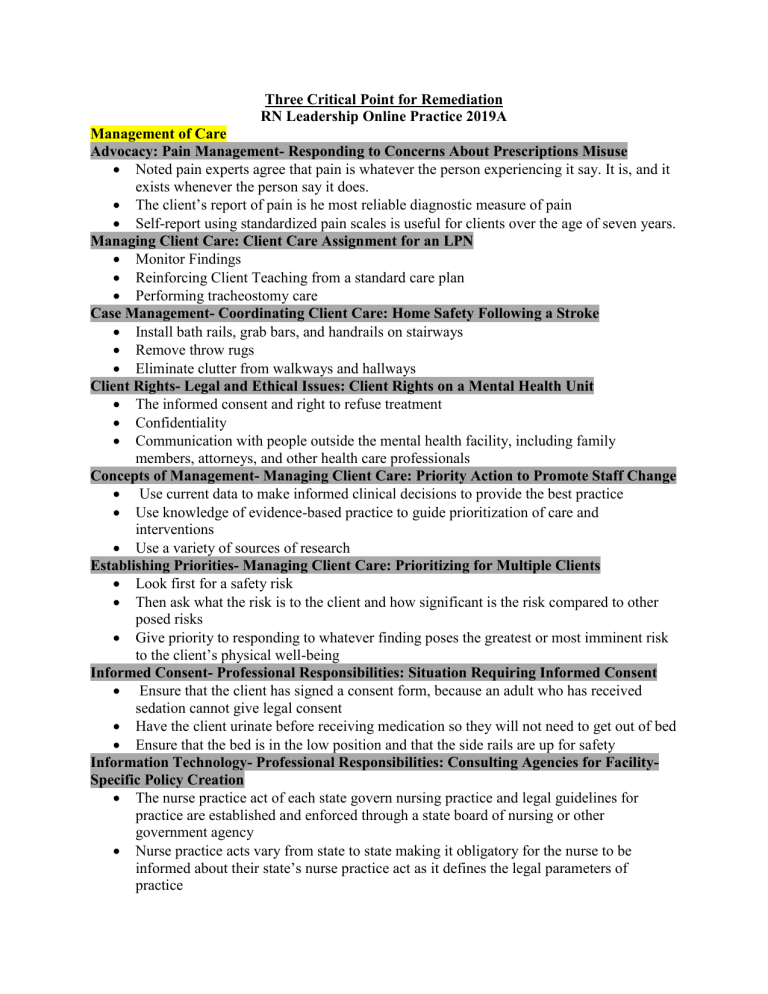
Three Critical Point for Remediation RN Leadership Online Practice 2019A Management of Care Advocacy: Pain Management- Responding to Concerns About Prescriptions Misuse Noted pain experts agree that pain is whatever the person experiencing it say. It is, and it exists whenever the person say it does. The client’s report of pain is he most reliable diagnostic measure of pain Self-report using standardized pain scales is useful for clients over the age of seven years. Managing Client Care: Client Care Assignment for an LPN Monitor Findings Reinforcing Client Teaching from a standard care plan Performing tracheostomy care Case Management- Coordinating Client Care: Home Safety Following a Stroke Install bath rails, grab bars, and handrails on stairways Remove throw rugs Eliminate clutter from walkways and hallways Client Rights- Legal and Ethical Issues: Client Rights on a Mental Health Unit The informed consent and right to refuse treatment Confidentiality Communication with people outside the mental health facility, including family members, attorneys, and other health care professionals Concepts of Management- Managing Client Care: Priority Action to Promote Staff Change Use current data to make informed clinical decisions to provide the best practice Use knowledge of evidence-based practice to guide prioritization of care and interventions Use a variety of sources of research Establishing Priorities- Managing Client Care: Prioritizing for Multiple Clients Look first for a safety risk Then ask what the risk is to the client and how significant is the risk compared to other posed risks Give priority to responding to whatever finding poses the greatest or most imminent risk to the client’s physical well-being Informed Consent- Professional Responsibilities: Situation Requiring Informed Consent Ensure that the client has signed a consent form, because an adult who has received sedation cannot give legal consent Have the client urinate before receiving medication so they will not need to get out of bed Ensure that the bed is in the low position and that the side rails are up for safety Information Technology- Professional Responsibilities: Consulting Agencies for FacilitySpecific Policy Creation The nurse practice act of each state govern nursing practice and legal guidelines for practice are established and enforced through a state board of nursing or other government agency Nurse practice acts vary from state to state making it obligatory for the nurse to be informed about their state’s nurse practice act as it defines the legal parameters of practice Published standards of nursing practice: these are developed by professional organizations such as ANA, ANPN. Referrals- Coordinating Client Care: Identifying a Referral for Who Has Osteoarthritis Refer to Occupational Therapist to assess and plan for clients to regain activities of daily living Pharmacist- provide, monitors, and evaluates medications Physical Therapist- assess and plans for clients to increase musculoskeletal function, especially of the lower extremities to maintain mobility. Safety and Infection Control Emergency Response Plan- Facility Protocols: Nursing Roles in Disaster Plan Class 1- Red tag:immediate threat to life Class 2- yellow tag, major injury Class 3- green tag, minor injury Standard Precautions/Transmission- Based Precautions/Surgical Asepsis: Maintaining a Safe Environmental: Evaluate Precautions implemented by Staff for a Client Who Has Tuberculosis Use airborne precautions to protect against droplet infections smaller than 5mcg. Such as private room, masks and respiratory protection for caregivers and visitors Negative pressure airflow exchange in the room of at least six to 12 exchanges an hour depending on the age of the structure



